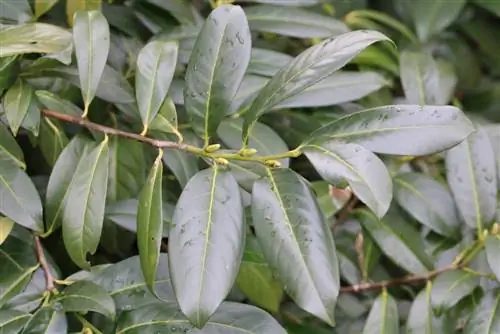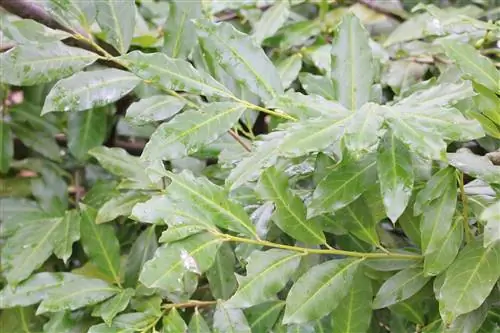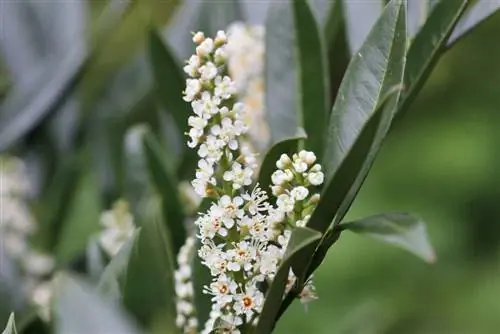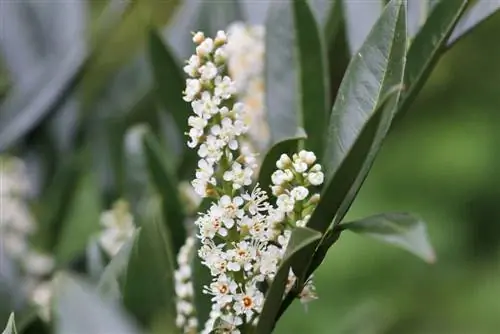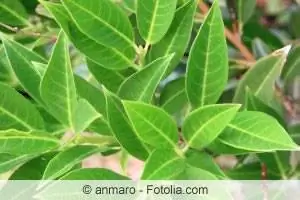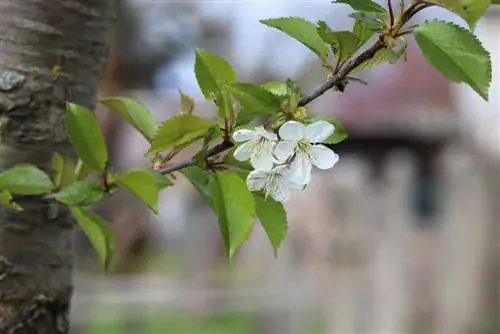- Author admin [email protected].
- Public 2023-12-17 03:39.
- Last modified 2025-01-24 12:45.
The Prunus lusitanica belongs to the rose family of plants. It is undemanding and develops a dense growth over time. As a heat-loving ornamental shrub, the Portuguese cherry laurel is extremely frost hardy and can withstand temperatures down to minus 20 °C. On the other hand, it can withstand extremely high temperatures and copes well with short dry periods. The attractive flower clusters immerse the Portuguese princess's foliage in a creamy white sea of flowers. The hedge plant is similar to the real laurel, but is not related to it.
Origin and appearance
As the name suggests, the Portuguese tree is native to the Azores and the Canary Islands, across the Iberian Peninsula to southwest France. There it looks for sunny locations in juniper forests and crater gorges. However, the pure wild form can hardly be found anywhere today. The Mediterranean plant owes its name to the Roman province of Lusitanica (today's Portugal).
Prunus lusitanica reaches a height of up to four meters in the home garden and takes up a width of up to two and a half meters. Depending on the location and pruning, the plant increases in size from 20 to 35 cm per year. The bushy and upright growing ornamental shrub shows its new shoots in an attractive red tone. The glossy leaves are leathery, dark green, ovate, pointed and have a striking red petiole. The creamy white flowers are upright and produce egg-shaped, dark red drupes. The plant is well suited as a hedge and can also be cultivated as a container plant.
Location
It doesn't take much effort to find the optimal location for the Mediterranean plant, as it is quite undemanding. Due to its origins, it is sun-drenched and therefore thrives best in a sunny to partially shaded spot. The Portuguese Princess can tolerate heat, but should be protected from the cool east wind.
Substrate
This cherry laurel variety, which is all too happy to show off countless small white flower clusters, also has no special demands on the soil conditions. Basically, the plant prefers loose and permeable soil. Such soil ensures that waterlogging cannot accumulate in the area of the roots. Because waterlogging damages the well-being of the Prunus lusitanica in the long term. It is also an advantage if the tree is planted in sandy-clay, gravelly-loamy or sandy-loamy soil.
Tip:
To emphasize the benefits of this plant, a nutrient-rich, slightly acidic to strongly alkaline soil is recommended.
Pouring
It has a positive effect on the appearance and growth of the Mediterranean beauty if it is watered less often but thoroughly. Thorough watering encourages the plant's roots to reach deeper layers of soil and thus survive short dry periods.
Tip:
To prevent fungal diseases, you should only water when the surface has dried out.
Fertilize
Basically, the Portuguese cherry laurel does not need to be fertilized. The ornamental shrub is well cared for initially if manure, horn shavings or compost are added to the soil when planting. Commercially available liquid fertilizer can also be used to ensure that the shrub is adequately supplied with nutrients. Fertilization is stopped from August onwards, otherwise too many new shoots will form that are sensitive to the coming cold.
Wintering
Although the Prunus lusitanica can tolerate temperatures down to -20 °C, the root area should not only be covered for young plants. Fir branches and leaves are suitable for covering. An additional layer of mulch provides the Portuguese laurel with nutrients. Tender little shrubs that have their first winter ahead of them are happy about protection from branches. As an evergreen tree, the cherry laurel needs sufficient water even in winter. Otherwise it will react with brown leaves after the winter months. However, watering is only done on frost-free days.
Cutting
In principle, the Prunus lusitanica can be cut back all year round - except in frost and on hot days in summer. Cutting is done after the flowering period. The shoots are shortened by five to ten centimeters. This has the advantage that the plant thrives better and shows its full blooms next year. Of course, the shoot tips can also be trimmed from time to time. This creates more branches. Mechanical hedge trimmers are recommended for cutting. An electric hedge trimmer can leave brown edges on the leaves.
Planting time
Root products, i.e. plants without balls, are best planted by the end of April. Autumn is also a perfect planting time. Container goods can be placed in the ground all year round. In dry conditions, ensure adequate watering. The planting hole should be twice the size of the ball. Horn shavings, manure or compost can be added as long-term fertilizer. No more than three plants per meter are placed in the ground. Finally, water well.
Diseases and pests
The most common diseases of cherry laurel are fungal diseases that severely affect the plant's metabolism.
Mildew
- flour-like coating on the leaves
- growing leaves are misshapen
- Leaves turn yellow to brown
- developed foliage is usually not affected
Shotgun disease
- small, bright dots in the leaf area
- red to brown spots on the leaves
- Disease also affects fruits and causes them to become crippled or split open
- shoots are sometimes also affected
Measures
- remove affected leaves and dispose of them with household waste
- Use fungicide preparations
- possibly additional copper donations
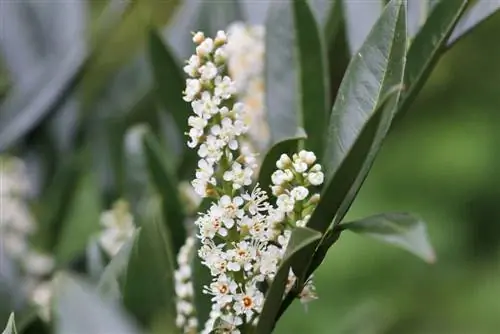
Mealybugs, mealybugs, aphids and scale insects are also characteristic. Pruning can also make sense here. To combat lice, we recommend a solution of soft soap enriched with a little spirit. If this does not lead to any results, the retailer has appropriate preparations available.
Frequently asked questions
How big will the plant get and at what distance should the Portuguese cherry laurel be planted when growing a hedge?
Prunus lusitanica can reach a height of four and a half to six meters. The width varies between three to five meters. No more than three plants per meter are planted as a hedge.
Are the fruits of the Portuguese laurel poisonous?
All parts of the plant, including the fruits, are poisonous. The leaves and seeds in particular have a high toxic potential. After consumption, the glycosides contained in the plant parts release hydrogen cyanide in the stomach. More than ten seeds can be fatal.
How do you explain yellow leaves after repotting?
Repotting means changed living conditions for the cherry laurel. Here it is enough to cut back the affected branches. If the tree is cultivated as a container plant, the container must be of sufficient size. It is also advisable to lay drainage so that rainwater can drain away unhindered.
What you should know about the Portuguese cherry laurel in brief
Care
- The Portuguese cherry laurel has no special requirements when it comes to soil conditions, it is content with normal garden soil.
- It likes a sunny or partially shaded location best.
- Because the plant originally comes from the Iberian Peninsula, the Azores and the Canary Islands, it is also very heat-tolerant.
- In its homeland, however, the Portuguese cherry laurel is only rarely found in the wild.
Planting time and winter care
- The best planting time for root crops, i.e. plants without pot balls, is spring until the end of April.
- Plants in a container, on the other hand, can be planted all year round.
- In dry weather, however, care should be taken to ensure adequate watering.
- Although this cherry laurel is very hardy, new plants should still receive winter protection in the first year.
- Young plants can also react somewhat sensitively to strong winter sun or cold wind.
Cutting the cherry laurel
- Basically, the Portuguese cherry laurel can be cut all year round.
- The only exceptions to this are the times when it is freezing and the summer months when it is very hot and dry.
- For gardeners, the time around St. John's Day on June 24th is a particularly popular time for pruning.
- In general, it is sufficient to shorten the shoots by about 5 to 10 cm once a year.
- However, the shoot tips can also be trimmed more often because this creates more branches.
Tip:
Because brown edges easily form on the leaves when using an electric hedge trimmer, it is advisable to cut young plants in particular by hand.
Conclusion
The Prunus lusitanica is well suited as a hedge plant because it grows up to two meters high and can grow up to 30 cm per year. It can also reach dimensions of up to one and a half meters in width. It forms a lot of branches, so that the hedge becomes very dense and thus forms a good privacy screen. The more you cut, the denser the hedge becomes. Depending on the size of the plants, two to three plants per linear meter are required for a hedge.

